Microflora - Study guides, Class notes & Summaries
Looking for the best study guides, study notes and summaries about Microflora? On this page you'll find 309 study documents about Microflora.
Page 3 out of 309 results
Sort by
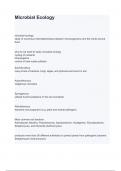
-
Microbial Ecology microbial ecology Questions and answers
- Exam (elaborations) • 9 pages • 2024
-
Available in package deal
-
- $7.99
- + learn more
Microbial Ecology microbial ecology study of numerous interrelationships between microorganisms and the world around them why do we need to study microbial ecology cycling of nutrients bioenergetics control of man-made pollution Soil Microflora many kinds of bacteria, fungi, algae, and protozoa are found in soil Autochthonous indigenous microbes Zymogeno
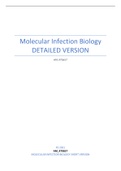
-
Molecular Infection Biology DETAILED VERSION
- Summary • 81 pages • 2022
-
- $6.64
- 3x sold
- + learn more
This summary was made for Molecular Infection Biology. The content is more detailed with context to everything you need to know for the exam. In the exam I remembered that you need to know a lot of the examples he described and that you need to write this down yourself. I scored an 8.5 for this course. I also made a short version that will only explain the essentials.
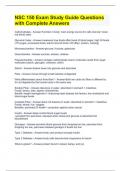
-
NSC 150 Exam Study Guide Questions with Complete Answers
- Exam (elaborations) • 11 pages • 2024
-
- $11.49
- + learn more
NSC 150 Exam Study Guide Questions with Complete Answers What is gluten - Answer-Gluten is a protein found in many grains, including wheat, barley and rye. Gluten provides no essential nutrients. It can trigger a severe autoimmune response or other unpleasant symptoms What causes Celiac disease - Answer-An abnormal immune system reaction to the protein gluten Normal fasting blood glucose levels - Answer-99 mg/dl or lower is normal, 100 to 125 mg/dl indicates you have prediabetes Prob...
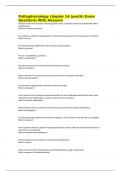
-
Pathophysiology chapter 14 (porth) Exam Questions With Answers Graded A+
- Exam (elaborations) • 14 pages • 2024
-
- $10.49
- + learn more
Pathophysiology chapter 14 (porth) Exam Questions With Answers Invasions of the human body by microorganisms that can produce harmful and potentially lethal consequences. What are infectious diseases? Any organism capable of supporting the nutritional and physical growth requirements of another. What is a host? The presence and multiplication within another living organism. What is infection? The act of establishing a presence. What is colonization? Harmless bacterial to...

-
NUR 350 EXAM 1 STUDY GUIDE QUESTIONS & ANSWERS SOLVED 100% CORRECT
- Exam (elaborations) • 14 pages • 2024
-
- $8.39
- + learn more
What should your nursing diagnosis be based on? - ️️Your assessment Characteristics of the pt What you can do to improve pt's quality of health Reduced or absent pedal pulse are defining characteristics of what NANDAs? - ️️decreased Cardiac Output ineffective peripheral Tissue Perfusion *there are likely more* What is secretory diarrhea? - ️️Diarrhea that occurs when ingested pathogens survive in the GI tract long enough to absorb into the enterocytes. Cell permeability c...
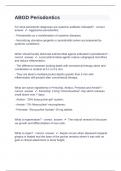
-
ABGD Periodontics Question and answers verified to pass 2024
- Exam (elaborations) • 8 pages • 2024
-
Available in package deal
-
- $12.99
- + learn more
ABGD Periodontics Question and answers verified to pass 2024 ABGD Periodontics For what periodontic diagnoses are systemic antibiotic indicated? - correct answer - Aggressive periodontitis; - Periodontitis as a manifestation of systemic diseases; - Necrotizing ulcerative gingivitis or periodontitis (when accompanied by systemic conditions) When should locally delivered antimicrobial agents indicated in periodontics? - correct answer - Local antimicrobial agents reduce subgingival mi...
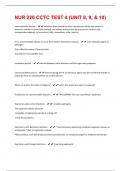
-
NUR 220 CCTC TEST 4 (UNIT 8, 9, & 10) 400 Questions And Answers Rated A+ New Update Assured Satisfaction
- Exam (elaborations) • 65 pages • 2024
- Available in package deal
-
- $10.99
- + learn more
communicable disease- - infection often caused by direct transmission (from one person or animal to another by body fluid contact), via indirect transmission (to a person by contact with contaminated objects), or by vectors (ticks, mosquitoes, other insects) For a communicable disease to occur three factors need to be in place: - 1) an infectious agent or pathogen 2) an effective means of transmission 3) presence of susceptible host Incubation period- - interval between initial infection ...
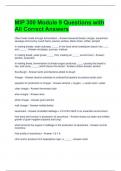
-
MIP 300 Module 9 Questions with All Correct Answers
- Exam (elaborations) • 4 pages • 2024
-
Available in package deal
-
- $10.99
- + learn more
MIP 300 Module 9 Questions with All Correct Answers Other foods made through fermentation - Answer-leavened bread, vinegar, sauerkraut, sausage and country-cured hams, sauces, pickles, black olives, coffee, tempeh In making breads, water activates _____ in the flood which breakdown starch into ____ and _____ - Answer-amylases, sucrose, maltose In making bread, yeast grows _____ first, creating an _____ environment - Answer-aerobic, anaerobic In making bread, fermentation of simple s...
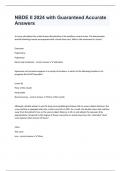
-
NBDE II 2024 with Guaranteed Accurate Answers
- Exam (elaborations) • 26 pages • 2024
-
Available in package deal
-
- $13.99
- + learn more
A 6-year-old patient has a dark brown discoloration of his maxillary central incisor. The discoloration started following trauma accompanied with a facial sinus tract. What is the treatment-of- choice? Extraction Pulpectomy Pulpotomy Direct pulp treatment - correct answer Extraction Squamous cell carcinoma appears in a variety of locations. In which of the following locations is its prognosis the LEAST favorable? Lower lip Floor of the mouth Hard palate Buccal mucosa - correct ans...
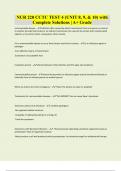
-
NUR 220 CCTC TEST 4 (UNIT 8, 9, & 10) with Complete Solutions | A+ Grade
- Exam (elaborations) • 65 pages • 2024
-
- $9.99
- + learn more
communicable disease- - infection often caused by direct transmission (from one person or animal to another by body fluid contact), via indirect transmission (to a person by contact with contaminated objects), or by vectors (ticks, mosquitoes, other insects) For a communicable disease to occur three factors need to be in place: - 1) an infectious agent or pathogen 2) an effective means of transmission 3) presence of susceptible host Incubation period- - interval between initial infection ...

Study stress? For sellers on Stuvia, these are actually golden times. KA-CHING! Earn from your study resources too and start uploading now. Discover all about earning on Stuvia


